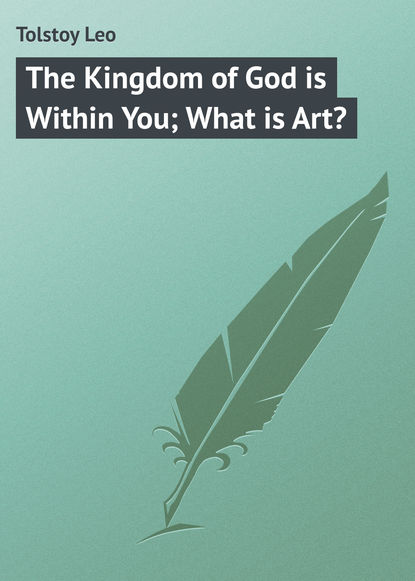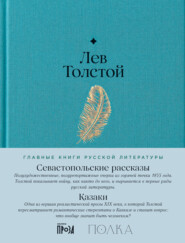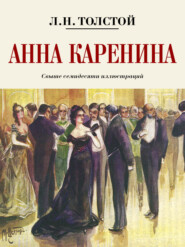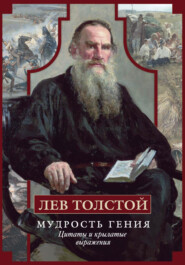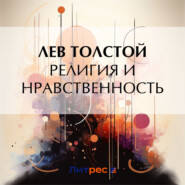По всем вопросам обращайтесь на: info@litportal.ru
(©) 2003-2024.
✖
The Kingdom of God is Within You; What is Art?
Настройки чтения
Размер шрифта
Высота строк
Поля
After these more eminent writers there followed, in Germany, less original and less influential ones, such as Hartmann, Kirkmann, Schnasse, and, to some extent, Helmholtz (as an æsthetician), Bergmann, Jungmann, and an innumerable host of others.
According to Hartmann (1842), beauty lies, not in the external world, nor in "the thing in itself," neither does it reside in the soul of man, but it lies in the "seeming" (Schein) produced by the artist. The thing in itself is not beautiful, but is transformed into beauty by the artist.[74 - Knight, pp. 81, 82.]
According to Schnasse (1798-1875), there is no perfect beauty in the world. In nature there is only an approach toward it. Art gives what nature cannot give. In the energy of the free ego, conscious of harmony not found in nature, beauty is disclosed.[75 - Knight, p. 83.]
Kirkmann wrote on experimental æsthetics. All aspects of history in his system are joined by pure chance. Thus, according to Kirkmann (1802-1884), there are six realms of history: The realm of Knowledge, of Wealth, of Morality, of Faith, of Politics, and of Beauty; and activity in the last-named realm is art.[76 - Schasler, p. 1121.]
According to Helmholtz (1821), who wrote on beauty as it relates to music, beauty in musical productions is attained only by following unalterable laws. These laws are not known to the artist; so that beauty is manifested by the artist unconsciously, and cannot be subjected to analysis.[77 - Knight, pp. 85, 86.]
According to Bergmann (1840) ("Ueber das Schöne," 1887), to define beauty objectively is impossible. Beauty is only perceived subjectively, and therefore the problem of æsthetics is to define what pleases whom.[78 - Knight, p. 88.]
According to Jungmann (d. 1885), firstly, beauty is a suprasensible quality of things; secondly, beauty produces in us pleasure by merely being contemplated; and, thirdly, beauty is the foundation of love.[79 - Knight, p. 88.]
The æsthetic theories of the chief representatives of France, England, and other nations in recent times have been the following: —
In France, during this period, the prominent writers on æsthetics were Cousin, Jouffroy, Pictet, Ravaisson, Lévêque.
Cousin (1792-1867) was an eclectic, and a follower of the German idealists. According to his theory, beauty always has a moral foundation. He disputes the doctrine that art is imitation and that the beautiful is what pleases. He affirms that beauty may be defined objectively, and that it essentially consists in variety in unity.[80 - Knight, p. 112.]
After Cousin came Jouffroy (1796-1842), who was a pupil of Cousin's and also a follower of the German æstheticians. According to his definition, beauty is the expression of the invisible by those natural signs which manifest it. The visible world is the garment by means of which we see beauty.[81 - Knight, p. 116.]
The Swiss writer Pictet repeated Hegel and Plato, supposing beauty to exist in the direct and free manifestation of the divine Idea revealing itself in sense forms.[82 - Knight, pp. 118, 119.]
Lévêque was a follower of Schelling and Hegel. He holds that beauty is something invisible behind nature – a force or spirit revealing itself in ordered energy.[83 - Knight, pp. 123, 124.]
Similar vague opinions about the nature of beauty were expressed by the French metaphysician Ravaisson, who considered beauty to be the ultimate aim and purpose of the world. "La beauté la plus divine et principalement la plus parfaite contient le secret du monde."[84 - "La Philosophie en France," p. 232.] And again, "Le monde entier est l'œuvre d'une beauté absolue, qui n'est la cause des choses que par l'amour qu'elle met en elles."
I purposely abstain from translating these metaphysical expressions, because, however cloudy the Germans may be, the French, once they absorb the theories of the Germans and take to imitating them, far surpass them in uniting heterogeneous conceptions into one expression, and putting forward one meaning or another indiscriminately. For instance, the French philosopher Renouvier, when discussing beauty, says, "Ne craignons pas de dire qu'une vérité qui ne serait pas belle, ne serait qu'un jeu logique de notre esprit et que la seule vérité solide et digne de ce nom c'est la beauté."[85 - "Du Fondement de l'Induction."]
Besides the æsthetic idealists who wrote and still write under the influence of German philosophy, the following recent writers have also influenced the comprehension of art and beauty in France: Taine, Guyau, Cherbuliez, Coster, and Véron.
According to Taine (1828-1893), beauty is the manifestation of the essential characteristic of any important idea more completely than it is expressed in reality.[86 - "Philosophie de l'Art," vol. i., 1893, p. 47.]
Guyau (1854-1888) taught that beauty is not something exterior to the object itself, – is not, as it were, a parasitic growth on it, – but is itself the very blossoming forth of that on which it appears. Art is the expression of reasonable and conscious life, evoking in us both the deepest consciousness of existence and the highest feelings and loftiest thoughts. Art lifts man from his personal life into the universal life by means, not only of participation in the same ideas and beliefs, but also by means of similarity in feeling.[87 - Knight, pp. 139-141.]
According to Cherbuliez, art is an activity, (1) satisfying our innate love of forms (apparences), (2) endowing these forms with ideas, (3) affording pleasure alike to our senses, heart, and reason. Beauty is not inherent in objects, but is an act of our souls. Beauty is an illusion; there is no absolute beauty. But what we consider characteristic and harmonious appears beautiful to us.
Coster held that the ideas of the beautiful, the good, and the true are innate. These ideas illuminate our minds and are identical with God, who is Goodness, Truth, and Beauty. The idea of Beauty includes unity of essence, variety of constitutive elements, and order, which brings unity into the various manifestations of life.[88 - Knight, p. 134.]
For the sake of completeness, I will further cite some of the very latest writings upon art.
"La Psychologie du Beau et de l'Art, par Mario Pilo" (1895), says that beauty is a product of our physical feelings. The aim of art is pleasure, but this pleasure (for some reason) he considers to be necessarily highly moral.
The "Essai sur l'Art Contemporain, par Fierens Gevaert" (1897), says that art rests on its connection with the past, and on the religious ideal of the present which the artist holds when giving to his work the form of his individuality.
Then again, Sar Peladan's "L'Art Idealiste et Mystique" (1894), says that beauty is one of the manifestations of God. "Il n'y a pas d'autre Réalité que Dieu, il n'y a pas d'autre Vérité que Dieu, il n'y a pas d'autre Beauté que Dieu" (p. 33). This book is very fantastic and very illiterate, but is characteristic in the positions it takes up, and noticeable on account of a certain success it is having with the younger generation in France.
All the æsthetics diffused in France up to the present time are similar in kind, but among them Véron's "L'Esthétique" (1878) forms an exception, being reasonable and clear. That work, though it does not give an exact definition of art, at least rids æsthetics of the cloudy conception of an absolute beauty.
According to Véron (1825-1889), art is the manifestation of emotion transmitted externally by a combination of lines, forms, colors, or by a succession of movements, sounds, or words subjected to certain rhythms.[89 - "L'Esthétique," p. 106.]
In England, during this period, the writers on æsthetics define beauty more and more frequently, not by its own qualities, but by taste; and the discussion about beauty is superseded by a discussion on taste.
After Reid (1704-1796), who acknowledged beauty as being entirely dependent on the spectator, Alison, in his "Essay on the Nature and Principles of Taste" (1790), proved the same thing. From another side this was also asserted by Erasmus Darwin (1731-1802), the grandfather of the celebrated Charles Darwin.
He says that we consider beautiful that which is connected in our conception with what we love. Richard Knight's work, "An Analytical Inquiry into the Principles of Taste," also tends in the same direction.
Most of the English theories of æsthetics are on the same lines. The prominent writers on æsthetics in England during the present century have been Charles Darwin (to some extent), Herbert Spencer, Grant Allen, Ker, and Knight.
According to Charles Darwin (1809-1882 – "Descent of Man," 1871), beauty is a feeling natural not only to man, but also to animals, and consequently to the ancestors of man. Birds adorn their nests and esteem beauty in their mates. Beauty has an influence on marriages. Beauty includes a variety of diverse conceptions. The origin of the art of music is the call of the males to the females.[90 - Knight, p. 238.]
According to Herbert Spencer (b. 1820), the origin of art is play, a thought previously expressed by Schiller. In the lower animals all the energy of life is expended in life-maintenance and race-maintenance; in man, however, there remains, after these needs are satisfied, some superfluous strength. This excess is used in play, which passes over into art. Play is an imitation of real activity; so is art. The sources of æsthetic pleasure are threefold: (1) That "which exercises the faculties affected in the most complete ways, with the fewest drawbacks from exercise," (2) "the difference of a stimulus in large amount, which awakens a glow of agreeable feeling," (3) the partial revival of the same, with special combinations.[91 - Knight, pp. 239, 240.]
In Todhunter's "Theory of the Beautiful" (1872), beauty is infinite loveliness, which we apprehend both by reason and by the enthusiasm of love. The recognition of beauty as being such depends on taste; there can be no criterion for it. The only approach to a definition is found in culture. (What culture is, is not defined.) Intrinsically, art – that which affects us through lines, colors, sounds, or words – is not the product of blind forces, but of reasonable ones, working, with mutual helpfulness toward a reasonable aim. Beauty is the reconciliation of contradictions.[92 - Knight, pp. 240-243.]
Grant Allen is a follower of Spencer, and in his "Physiological Æsthetics" (1877) he says that beauty has a physical origin. Æsthetic pleasures come from the contemplation of the beautiful, but the conception of beauty is obtained by a physiological process. The origin of art is play; when there is a superfluity of physical strength man gives himself to play; when there is a superfluity of receptive power man gives himself to art. The beautiful is that which affords the maximum of stimulation with the minimum of waste. Differences in the estimation of beauty proceed from taste. Taste can be educated. We must have faith in the judgments "of the finest-nurtured and most discriminative" men. These people form the taste of the next generation.[93 - Knight, pp. 250-252.]
According to Ker's "Essay on the Philosophy of Art" (1883), beauty enables us to make part of the objective world intelligible to ourselves without being troubled by reference to other parts of it, as is inevitable for science. So that art destroys the opposition between the one and the many, between the law and its manifestation, between the subject and its object, by uniting them. Art is the revelation and vindication of freedom, because it is free from the darkness and incomprehensibility of finite things.[94 - Knight, pp. 258, 259.]
According to Knight's "Philosophy of the Beautiful," Part II. (1893), beauty is (as with Schelling) the union of object and subject, the drawing forth from nature of that which is cognate to man, and the recognition in oneself of that which is common to all nature.
The opinions on beauty and on art here mentioned are far from exhausting what has been written on the subject. And every day fresh writers on æsthetics arise, in whose disquisitions appear the same enchanted confusion and contradictoriness in defining beauty. Some, by inertia, continue the mystical æsthetics of Baumgarten and Hegel with sundry variations; others transfer the question to the region of subjectivity, and seek for the foundation of the beautiful in questions of taste; others – the æstheticians of the very latest formation – seek the origin of beauty in the laws of physiology; and finally, others again investigate the question quite independently of the conception of beauty. Thus Sully, in his "Sensation and Intuition: Studies in Psychology and Æsthetics" (1874), dismisses the conception of beauty altogether, art, by his definition, being the production of some permanent object or passing action fitted to supply active enjoyment to the producer, and a pleasurable impression to a number of spectators or listeners, quite apart from any personal advantage derived from it.[95 - Knight, p. 243.]
CHAPTER IV
To what do these definitions of beauty amount? Not reckoning the thoroughly inaccurate definitions of beauty which fail to cover the conception of art, and which suppose beauty to consist either in utility, or in adjustment to a purpose, or in symmetry, or in order, or in proportion, or in smoothness, or in harmony of the parts, or in unity amid variety, or in various combinations of these – not reckoning these unsatisfactory attempts at objective definition, all the æsthetic definitions of beauty lead to two fundamental conceptions. The first is that beauty is something having an independent existence (existing in itself), that it is one of the manifestations of the absolutely Perfect, of the Idea, of the Spirit, of Will, or of God; the other is that beauty is a kind of pleasure received by us, not having personal advantage for its object.
The first of these definitions was accepted by Fichte, Schelling, Hegel, Schopenhauer, and the philosophizing Frenchmen, Cousin, Jouffroy, Ravaisson, and others, not to enumerate the second-rate æsthetic philosophers. And this same objective-mystical definition of beauty is held by a majority of the educated people of our day. It is a conception very widely spread, especially among the elder generation.
The second view, that beauty is a certain kind of pleasure received by us, not having personal advantage for its aim, finds favor chiefly among the English æsthetic writers, and is shared by the other part of our society, principally by the younger generation.
So there are (and it could not be otherwise) only two definitions of beauty: the one objective, mystical, merging this conception into that of the highest perfection, God – a fantastic definition, founded on nothing; the other, on the contrary, a very simple and intelligible subjective one, which considers beauty to be that which pleases (I do not add to the word "pleases" the words "without the aim of advantage," because "pleases" naturally presupposes the absence of the idea of profit).
On the one hand, beauty is viewed as something mystical and very elevated, but unfortunately at the same time very indefinite, and consequently embracing philosophy, religion, and life itself (as in the theories of Schelling and Hegel, and their German and French followers); or, on the other hand (as necessarily follows from the definition of Kant and his adherents), beauty is simply a certain kind of disinterested pleasure received by us. And this conception of beauty, although it seems very clear is, unfortunately, again inexact; for it widens out on the other side, i. e. it includes the pleasure derived from drink, from food, from touching a delicate skin, etc., as is acknowledged by Guyau, Kralik, and others.
It is true that, following the development of the æsthetic doctrines on beauty, we may notice that, though at first (in the times when the foundations of the science of æsthetics were being laid) the metaphysical definition of beauty prevailed, yet the nearer we get to our own times the more does an experimental definition (recently assuming a physiological form) come to the front, so that at last we even meet with such æstheticians as Véron and Sully, who try to escape entirely from the conception of beauty. But such æstheticians have very little success, and with the majority of the public, as well as of artists and the learned, a conception of beauty is firmly held which agrees with the definitions contained in most of the æsthetic treatises, i. e. which regards beauty either as something mystical or metaphysical, or as a special kind of enjoyment.
What, then, is this conception of beauty, so stubbornly held to by people of our circle and day as furnishing a definition of art?
In the subjective aspect, we call beauty that which supplies us with a particular kind of pleasure.
In the objective aspect, we call beauty something absolutely perfect, and we acknowledge it to be so only because we receive, from the manifestation of this absolute perfection, a certain kind of pleasure; so that this objective definition is nothing but the subjective conception differently expressed. In reality both conceptions of beauty amount to one and the same thing; namely, the reception by us of a certain kind of pleasure; i. e. we call "beauty" that which pleases us without evoking in us desire.
Such being the position of affairs, it would seem only natural that the science of art should decline to content itself with a definition of art based on beauty (i. e. on that which pleases), and seek a general definition, which should apply to all artistic productions, and by reference to which we might decide whether a certain article belonged to the realm of art or not. But no such definition is supplied, as the reader may see from those summaries of the æsthetic theories which I have given, and as he may discover even more clearly from the original æsthetic works, if he will be at the pains to read them. All attempts to define absolute beauty in itself – whether as an imitation of nature, or as suitability to its object, or as a correspondence of parts, or as symmetry, or as harmony, or as unity in variety, etc. – either define nothing at all, or define only some traits of some artistic productions, and are far from including all that everybody has always held, and still holds, to be art.
There is no objective definition of beauty. The existing definitions (both the metaphysical and the experimental) amount only to one and the same subjective definition, which (strange as it seems to say so) is, that art is that which makes beauty manifest, and beauty is that which pleases (without exciting desire). Many æstheticians have felt the insufficiency and instability of such a definition, and, in order to give it a firm basis, have asked themselves why a thing pleases. And they have converted the discussion on beauty into a question concerning taste, as did Hutcheson, Voltaire, Diderot, and others. But all attempts to define what taste is must lead to nothing, as the reader may see both from the history of æsthetics and experimentally. There is and can be no explanation of why one thing pleases one man and displeases another, or vice versa. So that the whole existing science of æsthetics fails to do what we might expect from it, being a mental activity calling itself a science; namely, it does not define the qualities and laws of art, or of the beautiful (if that be the content of art), or the nature of taste (if taste decides the question of art and its merit), and then, on the basis of such definitions, acknowledge as art those productions which correspond to these laws, and reject those which do not come under them. But this science of æsthetics consists in first acknowledging a certain set of productions to be art (because they please us), and then framing such a theory of art that all those productions which please a certain circle of people should fit into it. There exists an art canon, according to which certain productions favored by our circle are acknowledged as being art, – Phidias, Sophocles, Homer, Titian, Raphael, Bach, Beethoven, Dante, Shakespear, Goethe, and others, – and the æsthetic laws must be such as to embrace all these productions. In æsthetic literature you will incessantly meet with opinions on the merit and importance of art, founded not on any certain laws by which this or that is held to be good or bad, but merely on the consideration whether this art tallies with the art canon we have drawn up.
The other day I was reading a far from ill-written book by Folgeldt. Discussing the demand for morality in works of art, the author plainly says that we must not demand morality in art. And in proof of this he advances the fact that if we admit such a demand, Shakespear's "Romeo and Juliet," and Goethe's "Wilhelm Meister," would not fit into the definition of good art; but since both these books are included in our canon of art, he concludes that the demand is unjust. And therefore it is necessary to find a definition of art which shall fit the works; and instead of a demand for morality, Folgeldt postulates as the basis of art a demand for the important (Bedeutungsvolles).





